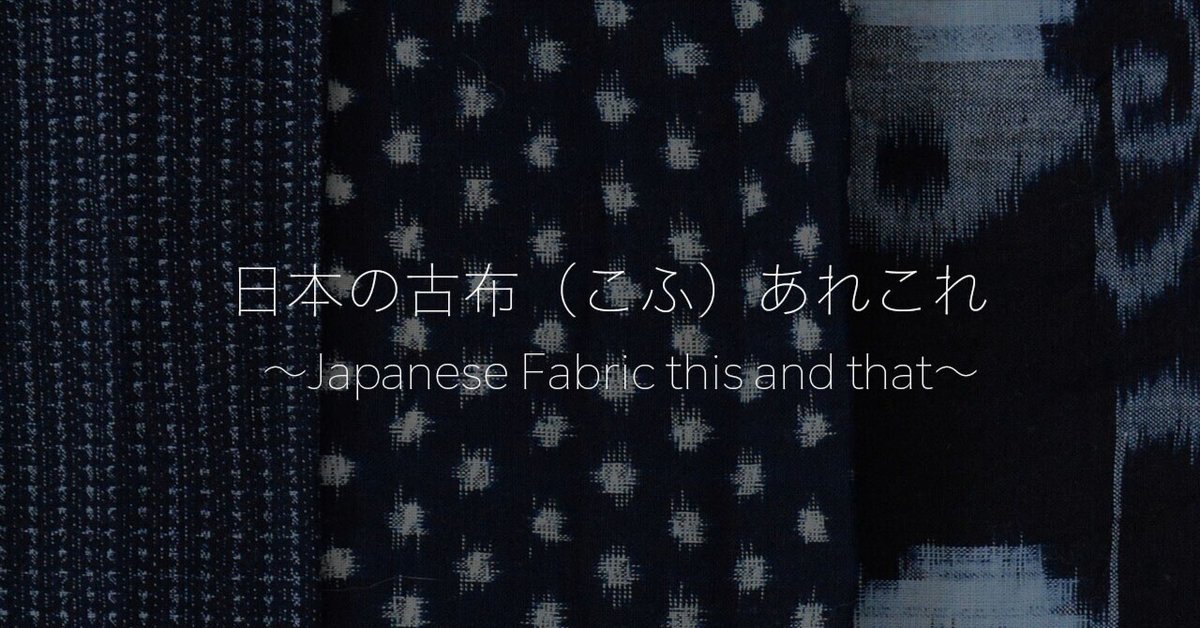
日本の古布(こふ)あれこれ | Japanese Fabric this and that
ご訪問いただきありがとうございます。
まだまだnote自体、書くことにも不慣れですが、頑張って書いていきたいと思っておりますので、今回も宜しくお願い申し上げます。
今回は古布(こふ)。
ジャパンヴィンテージの中でも、敷居が低く、奥深い、そして最高にかっこよくて楽しい。
現代の我々にも多くを気づかせてくれるアイテムです。
Thank you for visiting us.
I'm still inexperienced in writing the note itself, but I'd like to do my best to write it, so I'd like to ask for your support this time.
Japanese fabric this time.
Even among Japan vintage, the threshold is low, it is deep, and it is the coolest and most fun.
It is an item that reminds us of many things today.
古布とは? | What is japanese fabric?

古布(こふ)は、主に昭和の中期頃まで使用されていた布のことです。
また、着物や衣服等を解いて布に戻した物も古布に含まれます。
日本は基本的に物資や自己資源が少ない国であり、昭和の初期頃まで、綿花や布は大変な貴重品でした。
「小豆3粒包める布は捨てるな」という言葉もあったりと、当時の布(今の古布ですね。)は珍重されておりました。
→襤褸←に関しても是非、ご覧ください。
※ここで言う古布(こふ)は、現在の中古の布全般を指すものではございません。
Japanese fabric is a fabric that was mainly used until the mid-Showa period.
Japanese fabric also includes items that have been unwound from kimonos, clothes, etc. and returned to cloth.
Japan is basically a country with few goods and self-resources, and cotton and cloth were very valuable goods until the early Showa era.
Cloth was highly prized at the time, as there is a saying, ''Don't throw away a cloth that can wrap three beans.''
Please also take a look at →Boro←.
※The Japanese fabric mentioned here does not refer to current used fabrics in general.
多種多様な古布の種類 | A wide variety of Japanese fabric types
使用用途等により、古布も様々な物が存在します。
ここでは、簡単にその種類について書かせていただきます。
There are various types of old cloth depending on the purpose of use.
Here, I will briefly describe the types.
1.はぎれ(端切れ) | Scraps

着物や衣服、反物を解いた布状の物。
または、布の切れ端、裁断後の残り布。
はぎれはサイズが小さい物がメインになりますので、リメイクやリペア素材、アートファブリックとして楽しまれている方が多い印象です。
Kimono, clothes, and cloth-like items unraveled from rolls.
Or scraps of fabric, leftover fabric after cutting.
Scraps are mainly small in size, so I have the impression that many people enjoy them as remakes, repair materials, and art fabrics.
2.風呂敷(ふろしき) | Furoshiki

物を包み、持ち運びや収納する為の布を風呂敷(ふろしき)と言います。
風呂敷の名前の由来は、室町時代末期に大名が風呂(ふろ)に入る際に布を広げ、その上で脱衣等を行い衣服を包んだり、足拭きにした説。
また、茶道の道具として用いられる風炉に由来するとの説もございます。
日本人にとっては非常に馴染み深いもので、明治時代以降、鞄の流入により利用自体は減っていますが、近年のエコ志向や日本文化の再評価の動きもあり、復権の兆しが見えるアイテムでもあります。
Furoshiki is a cloth used to wrap, carry and store things.
The origin of the name of furoshiki is that in the late Muromachi period, feudal lords spread out cloth when they took a bath, undressed on it, wrapped their clothes, and wiped their feet.
There is also a theory that it originated from the furo used as a tool for the tea ceremony.
It is very familiar to Japanese people, and since the Meiji era, the use of bags has decreased due to the influx of bags.
3.酒袋 | Sake Bag

酒のもろみを入れ、絞るのに用いる袋のこと。
長期間使用するため、酒搾り後(主に夏)に、柿渋(かきしぶ)を塗り保管します。
この柿渋には防腐、防水効果があり、柿渋とアルコールが反応し、画像のような独特の深みある色合いになります。
現在では、自動醪圧搾機が普及したため、酒袋を用いて上槽する酒蔵は少なくなりました。
また、近年の酒袋はナイロンやテビロン、テトロンなどが主流になり、この木綿の太糸を荒めに織った織物のタイプはなかなか見掛ける機会も少なくなりました。
A bag used for squeezing sake moromi.
For long-term use, apply kakishibu after squeezing (mainly in summer) and store.
This kakishibu has an antiseptic and waterproof effect, and kakishibu reacts with alcohol to create a unique deep color like the image.
Nowadays, with the widespread use of automatic mash presses, the number of sake breweries that use cotton sake bags for joshu has decreased.
In recent years, nylon, Teviron, Tetoron, etc. have become mainstream for sake bags, and it is rare to see this type of fabric that is roughly woven with thick cotton threads.
4.布団皮・こたつ布団 | Futon・Kotatsu Cover

布団皮(ふとんがわ)…..中綿布団の外側の布。今で言う布団カバー。
こたつ布団(こたつふとん)…..こたつの熱が逃げないようこたつを覆う布。
どちらも防寒性を高めるための布です。
現代においては、それぞれ中綿の素材が真綿や羽毛、化学繊維と色々ございますが、昔の布団皮とこたつ布団は基本的に真綿が多いように思います。
形が大きいため、見栄えするので、ディスプレイとしてお使いになられたり、細かく切って、リメイクやリペア素材等、自由にお使いになられているようです。(ある意味、丹前等も一緒かもしれません。)
Futon Cover…..The outer cloth of the batting futon. A modern duvet cover.
Kotatsu Futon Cover…..A cloth that covers the kotatsu to prevent heat from escaping.
Both are cloths to increase cold weather resistance.
In modern times, there are various filling materials such as cotton, feathers, and synthetic fibers, but I think that the old Futon Cover and Kotatsu Futon Cover are basically made of cotton.
Because of its large shape, it looks good, so it seems that it is used as a display, cut into small pieces, and used freely for remakes and repair materials. (In a sense, Tanzen and others may be the same.)
5.粉袋 | Powder Bag

小麦やふすま(麦の皮)を入れる袋を粉袋と言います。
販売や保管、運搬時に使用され、企業のネーミングやデザインが豊富で、見るだけでも楽しい袋かもしれません。
A bag that contains wheat or barley husk is called a flour bag.
They are used for sale, storage, and transportation, and they have a wide variety of company names and designs.


特に戦前の粉袋は非常に自由なデザインが多く、海外の影響や時代背景、様々な物が見えてきます。そして、めちゃめちゃかっこいい!!
In particular, many of the pre-war powder bags have a very free design, and you can see the influence of overseas, the historical background, and various things. And it's so cool!!!!!
6.用途不明のつぎはぎ布 | Unknown Patchwork Fabric

何に使われていたのか分からない布があります。
サイズや生地も様々で、用途をあれこれ想像するのも楽しいです。
襤褸に通じるものもございますが、究極の一点物、アートピースのようで、ついつい集めてしまいます。(個人的にこの用途不明の布が一番好きです。)
古布全般、人気が高いですが、つぎはぎ関係は海外の方から特に評価が高い気がします。
There is a piece of cloth that I don't know what it was used for.
There are various sizes and fabrics, and it's fun to imagine the uses.
There are things that are similar to boro, but they are like the ultimate one-of-a-kind art pieces, and I can't help but collect them. (Personally, I like this useless cloth the best.)
Japanese fabrics in general are very popular, but I feel that patchwork is especially popular among people overseas.
7.その他 | Others
他にも帯揚げや帯、反物関係、まだまだございますが、それは後日、ご紹介できればと思います。
There are still more obiage, obi, and rolls, but I hope I can introduce them at a later date.
難波商店的、古布の使い方 | How to use old cloth like Namba shouten

リメイクやリペア素材としてお使いいただくのは勿論、難波商店としては古布を身に纏い、ファッションとして楽しむのが気分です。
日本の古布は、テキスタイルデザインとしてオンリーワンですし、他の国の布では感じることのできない魅力があります。
シンプルに合わせるだけでオシャレですし、日本の古布でそれをやるのが、ポイントです。
Not only can you use it as a remake or repair material, but as Namba Shouten, I feel like wearing Japanese fabric and enjoying it as fashion.
Old Japanese fabrics are unique in terms of textile design, and they have a charm that cannot be felt with fabrics from other countries.
It's fashionable just by matching it simply, and the point is to do it with Japanese fabric.

シンプルに古布を首に巻き、スカーフ感覚で使ってみました。
野良着もそうですが、普通の洋服との相性が良く、デイリーにお使いいただけます。
古布のサイズやテキスタイルデザイン、カラーリングによって無限のバリエーションがあります。
ただの布ではなく、美しい布、それが古布です。
国内を探しても良い物はどんどん減っておりますので、お急ぎください。
ご覧いただきありがとうございました。
I simply wrapped old cloth around my neck and used it like a scarf.
The same is true for noragi, but it goes well with ordinary clothes and can be used daily.
There are infinite variations depending on the size of old cloth, textile design, and coloring.
Japanese Fabric is not just a fabric, but a beautiful fabric.
The number of items that can be found domestically is decreasing, so please hurry.
Thank you.
この記事が気に入ったらサポートをしてみませんか?
